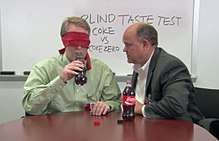Blind taste test
In marketing, a blind taste test is often used as a tool for companies to compare their brand to another brand. For example, the Pepsi Challenge[1] is a famous taste test that has been run by Pepsi since 1975. Additionally, taste tests are sometimes used as a tool by companies to develop their brand or new products.

Blind taste tests are ideal for goods such as food or wine that are consumed directly. Researchers use blind taste tests to obtain information about customers' perceptions and preferences on the goods. Blind taste test can be used to:[2]
- Track views on a product over time
- assess changes or improvements made to a product
- gauge reactions to a new product
.jpg) Maple syrup Tasting
Maple syrup Tasting
What is a blind taste test
Blind taste tests require a "blind testing" meaning the people taking the blind taste test are unaware of the identity of the brand being tested,[3] or if done at home this can be as simple as a blindfold over the person taking the test. This means that any bias, preconceived ideas about a particular brand or food, is eliminated. The people taking the test will also be unaware of any changes done to the product.[2]
In the famous Pepsi Challenge,[1] people took a sip from two different unlabelled glasses, not knowing which was Coke and which was Pepsi.
Types of blind taste tests

There are two types of blind taste tests:
- In a Single blind taste test, experimenters know information about the participants, but the participants know nothing about the experimenters or the product they are testing. The aforementioned Pepsi Challenge is an example of a single blind test.
- In a double blind taste test, the experimenters know nothing about the participants, and the participants know nothing about the experimenters or the product they are testing.
In popular culture
Taste tests are commonly employed by the public television show America's Test Kitchen and its spin-off series Cook's Country, typically administered by Jack Bishop.[4]
References
- Gee, James Paul (2010-05-22). "Sociocultural theory and blind taste-tests". Reading and Writing. 1 (1). doi:10.4102/rw.v1i1.7. ISSN 2308-1422.
- "Carrying out taste tests - Consumer focused product development - GREGGS | GREGGS case studies and information | Business Case Studies". businesscasestudies.co.uk. Retrieved 2016-10-23.
- Luis Méndez, José; Oubiña, Javier; Rubio, Natalia (2011). "The relative importance of brand‐packaging, price and taste in affecting brand preferences". British Food Journal. 113 (10): 1229–1251. doi:10.1108/00070701111177665.
- "'Test Kitchen': Have Your (Gluten-Free) Cake, And Love Eating It Too". NPR via OPB. 2014-03-20. Archived from the original on 2014-04-15. Retrieved 2014-04-14.